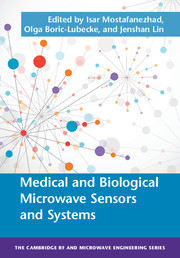Book contents
- Frontmatter
- Contents
- Contributors
- 1 Implantable Wireless Medical Devices for Gastroesophageal Applications
- 2 Embedded Wireless Device for Intracranial Pressure Monitoring
- 3 Wireless Intracranial Pressure Systems for the Assessment of Traumatic Brain Injury
- 4 Microwave Biosensors for Noninvasive Molecular and Cellular Investigations
- 5 Wearable Radar Tag Systems for Physiological Sensing/Monitoring
- 6 Physiological Radar Sensor Chip Development
- 7 Noise- and Interference-Reduction Methods for Microwave Doppler Radar Vital Signs Monitors
- 8 Biomedical Applications of UWB Technology
- Index
- References
4 - Microwave Biosensors for Noninvasive Molecular and Cellular Investigations
- Frontmatter
- Contents
- Contributors
- 1 Implantable Wireless Medical Devices for Gastroesophageal Applications
- 2 Embedded Wireless Device for Intracranial Pressure Monitoring
- 3 Wireless Intracranial Pressure Systems for the Assessment of Traumatic Brain Injury
- 4 Microwave Biosensors for Noninvasive Molecular and Cellular Investigations
- 5 Wearable Radar Tag Systems for Physiological Sensing/Monitoring
- 6 Physiological Radar Sensor Chip Development
- 7 Noise- and Interference-Reduction Methods for Microwave Doppler Radar Vital Signs Monitors
- 8 Biomedical Applications of UWB Technology
- Index
- References
Summary
This chapter will give a status on the current possibilities of analysis at the molecular and cellular levels enabled by the convergence of microwave dielectric spectroscopy and the use of microtechnologies. Highlights of the technique will be addressed, such as its noninvasivity, its specificity in terms of high-frequency signature, its compatibility with high ionic and nutrient contents classically encountered with cell culture media, and its suitability and sufficient sensitivity for cell probing, even down to single-cell investigations. These particularities notably will be performed in the context of cancer studies in order to offer complementary noninvasive analyzing tools to the biologists and physicians for living cells in their typical liquid microenvironment.
Introduction
There are plenty of physical ways to identify and characterize (bio-)matter physically and/or chemically. Whereas humans exploit their traditional senses (sight, hearing, taste, smell, and touch) to probe the environment, (artificial) sensors – especially biosensors, which are the topic of this chapter – also rely on such sensing mechanisms, for example, mechanical (touch) and optical (sight), but also on other types of interactions, for example, electromagnetic. Such techniques feature a key characteristic: the frequency of the electromagnetic waves can be varied over a range (narrow or broad) to get a rich set of data from spectra, and consequently, the technique is called spectroscopy. Combined with the massive progress in micro- and nanotechnology, miniature biosensors based on dielectric spectroscopy have been in use for several decades, first initiated in direct current (dc) and low frequencies (kilohertz and megahertz) and now reaching microwave and millimeter-wave ranges.
This chapter aims at showing the status of the current possibilities of analysis at the molecular and cellular levels enabled by the convergence of microwave dielectric spectroscopy and the use of microtechnologies. To understand the interests of developing microwave-based and miniature biosensors for molecular and cellular investigations, examples of the main and current cellular analyzing techniques that are available in biolabs will be given, followed by an introduction to microwave dielectric spectroscopy. Highlights of such a technique will then be addressed in terms of noninvasivity, specificity, compatibility with the high ionic and nutrient contents classically encountered in cell culture media, and suitability and sufficient sensitivity for cell probing, even down to single-cell investigations.
- Type
- Chapter
- Information
- Medical and Biological Microwave Sensors and Systems , pp. 124 - 153Publisher: Cambridge University PressPrint publication year: 2017



